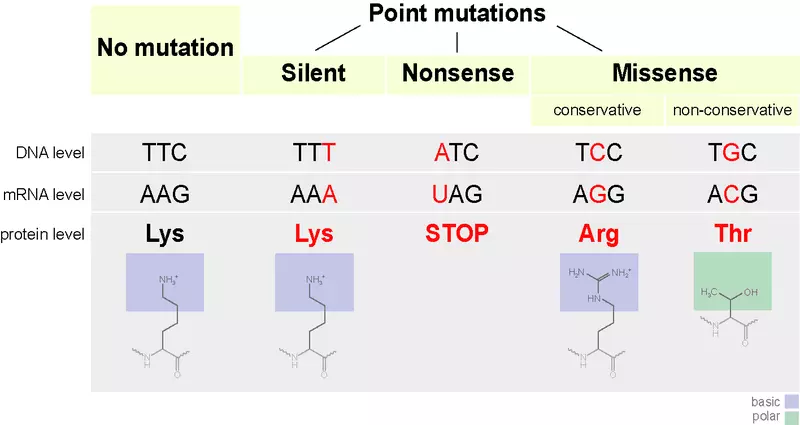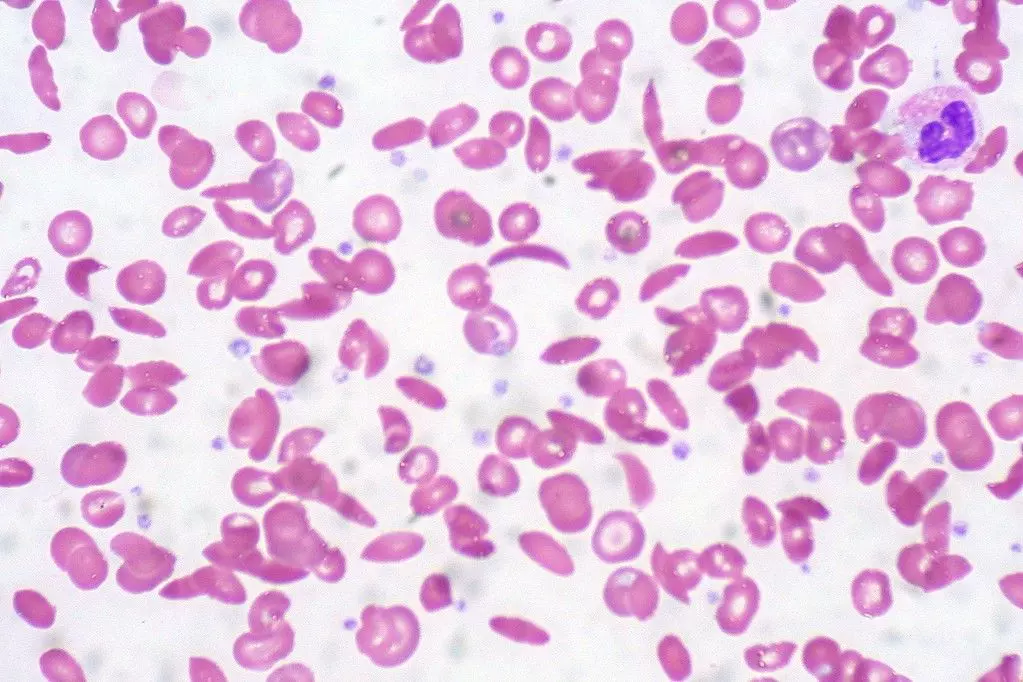Next Lesson - DNA Repair and Cancer
Core
Mutation has two definitions. A mutation is a heritable alteration in a gene or chromosome, mutation is the process which produces that alteration.
Things which cause mutations are called mutagens. These can be exogenous or endogenous.
Common exogenous mutagens can be in the form of ionising radiation and free radicals. This is important to remember as some medical imaging modalities use ionising radiation and thus can cause mutations with prolonged exposure. Therefore, imaging should be ordered only when necessary and should use radiation which is as low as reasonably achievable (ALARA). Other exogenous mutagens are chemicals and anti-cancer agents. Some anti-cancer agents work by purposefully mutating DNA in cancer cells in order to inhibit their ability to undergo mitosis and grow.
Endogenous mutagens can either be in the form of DNA replication defects, or transposable elements. Transposable elements (also known as 'jumping genes') are specific DNA sequences which move (transpose) to random sites in DNA, and can insert themselves into a gene and inactivate it.
Both exogenous and endogenous mutagens can lead to defective or error-prone DNA repair which eventually lead to mutations, or mutagens can directly affect a gene product
Mutations will do one of the following:
- Change the gene products.
- Change the amount of the gene product.
- Change the length of the polypeptide.
- Have no effect.
Mutations can have differing effects on the synthesis of a polypeptide, from no effect, to a large frameshift (discussed later).
- Neutral Mutations – have neither a detrimental nor a beneficial effect on an organism’s survival.
- Silent Mutations – have no effect on an organism’s phenotype, e.g. if the mutation still leads to the same amino acid being coded for due to the degeneracy of DNA.
- Synonymous Mutations – often the term is used interchangeably with silent mutations, however a synonymous mutation can affect transcription, splicing, mRNA transport, or translation; a change in any of these can affect phenotype.
- Missense Mutations – a mutation which results in a different codon for a different amino acid, thus affecting the polypeptide chain. Extension - There are two further classifications of missense mutation.
- Conservative Missense Mutations – a mutation results in a different amino acid with similar chemical properties to the original being incorporated into the polypeptide.
- Non-conservative Missense Mutations – a mutation results in a different amino acid with different chemical properties to the original being incorporated into the polypeptide.
- Nonsense Mutations – a mutation which results in the formation of an premature stop codon.

Diagram: Shows the types of different point mutations, and the effects these can have on the amino acid
Creative commons source by Jonsta247 [CC BY-SA 4.0 (https://creativecommons.org/licenses/by-sa/4.0)]
We can also classify mutations as somatic (occurring in a regular body cell, which will limit the effect of the mutation) or germ-line (occurring in a germ cell like a spermatocyte or an oocyte, which may have a drastic effect on an offspring which inherits this mutation).
Finally, mutations can either be dominant or recessive. Recessive mutations tend to cause a loss of function and often affect biochemical pathways. Dominant mutations tend to cause increased function and often cause structural abnormalities. These statements are not hard and fast rules, but instead trends which have been noted.
It is much more likely to a mutation to be recessive, as there are far more ways in which you can inactivate a gene whereas it is much more difficult to introduce an activating mutation. Failure of one allele can be compensated for by a normally functioning allele – hence it is recessive. Overproduction caused by one allele cannot be compensated for by a normal allele – hence it is dominant.
Mutations can occur at the level of single bases (micro) or at the level of chromosomes (macro).
Single Nucleotide Mutations (Micromutations)
There are 3 main categories of micromutation.
- Deletion
- A single base is removed from a strand of DNA.
- This will cause a frameshift.
- Insertion
- A single base is added to a strand of DNA.
- This will cause a frameshift.
- Substitution
- A single base is exchanged for another one. There are two subtypes:
- Transition – a change of a purine to a purine (A↔G) or a pyrimidine to a pyrimidine (T↔C).
- Transversion – a change of a purine to a pyrimidine or vice versa (A/G↔C/T).
- Substitution will not cause a frameshift.
- A single base is exchanged for another one. There are two subtypes:
Frameshift occurs when the DNA reading frame is disrupted by the insertion or deletion of a nucleotide. This has a large downstream effect on all subsequent codons which results in many incorrect amino acids being incorporated into the polypeptide chain.
An example of a disease caused by a single nucleotide mutation is Sickle Cell Anaemia:
This is an inherited disorder of the haemoglobin gene HBB. This mutation causes haemoglobin to precipitate in low oxygen conditions, and causes red blood cells to take on a characteristic sickle shape. This leads to a susceptibility to infections, weakness, impaired growth, and anaemia which is made worse when oxygen is limited.

Diagram: Shows a blood film with sickled red blood cells. These are the abnormally shaped cells that look elongated.
Creative commons source by Ed Uthman [CC BY-SA 4.0 (https://creativecommons.org/licenses/by-sa/4.0)]
The mutation which causes this is substitution (transversion) mutation in codon 7 of HBB where GAG -> GTG. This causes the normal amino acid glutamic acid to become valine.
Chromosomal Mutations (Macromutations)
As the name suggests, these mutations affect entire chromosomes.
- Deletion
- A large part of a chromosome is deleted.
- Duplication
- A large part of a chromosome is duplicated and inserted directly after the original part.
- Inversion
- A large part of a chromosome is flipped, so it is now ‘back-to-front’.
- Substitution
- A large part of a chromosome is inserted into another chromosome.
- Translocation
- A large part of a chromosome is swapped with a large part of another chromosome.
As somatic cells have pairs of chromosomes, a chromosomal mutation is unlikely to have a large effect. However, problems tend to arise in germ-line cells through meiosis, as two of the four daughter cells will contain copies of the mutated chromosome.
A special kind of translocation called Robertsonian translocation can lead to trisomies in offspring. Robertsonian translocation can only occur in acrocentric chromosomes. Therefore, chromosome 21 can be affected. A Robertsonian translocation occurs when the ‘p’ arms of the chromosome pair break off and are lost, which then allows the remaining q arms to fuse together creating one ‘big’ chromosome rather than a homologous pair. This causes issues if occurring in the germ line as the ‘big’ chromosome enter one cell and be inherited meaning the fertilised egg will contain 3 copies of the genetic information two of which on the ‘big’ chromosome.
Nondisjunction is a type of chromosome mutation which occurs during metaphase of mitosis. A failure of chromosomes to line up on the metaphase plate can result in anaphase lag, where a chromosome pair will not move properly to each pole during anaphase. This results in one daughter cell receiving two copies of a chromosome, and the other cell receiving no copies. This type of mutation is usually fatal to the daughter cell lacking a copy of the chromosome.
Cells receiving two copies of a chromosome will have an increase in the expression of the genes contained on the extra chromosome. If the genes function to slow cell growth, they may be fatal to the cell. If the genes promote growth, the cell may grow uncontrollably which may lead to cancer.
Mutations in mitochondrial DNA (mtDNA) can cause mitochondrial disease. Mitochondrial diseases are more pronounced if they were caused by a germ-line mutation as diseased mitochondria are present in multiple organ systems. The effects of these conditions are most observed in organs and tissues which require a lot of energy e.g. the heart, brain, and muscles.
Frequently observed symptoms include: muscle weakness and wasting, problems with movement, diabetes, kidney failure, heart disease, dementia, hearing loss, and abnormalities involving vision.
Mitochondrial mutations are only passed on down the maternal line, as mitochondrial in sperm are expended to provide movement, so are discarded on fusion with an oocyte.
Somatic mutations in mitochondria build up over time, due to the limited ability of mtDNA to repair itself. A build-up of these mutations has been linked to some forms of cancer, and increased risk of age-related diseases like heart disease, Alzheimer’s disease, and Parkinson’s disease.
Mutations in Early Embryogenesis
Imagine if there was a mitotic chromosomal mutation in one of the cells at the two cell or four cell stage of embryogenesis. This mutation will be widespread throughout the body of the fully grown individual. This makes the genetic information inside cells highly heterogenous. This is called mosaicism.

Diagram: Illustrates how a genetic mutation at an early stage in embryonic development can be present at many different locations in a full grown adult.
Creative commons source by Genomics Education Programme [CC BY-SA 4.0 (https://creativecommons.org/licenses/by-sa/4.0)]
Edited by: Dr. Ben Appleby and Bethany Turner
- 11357

